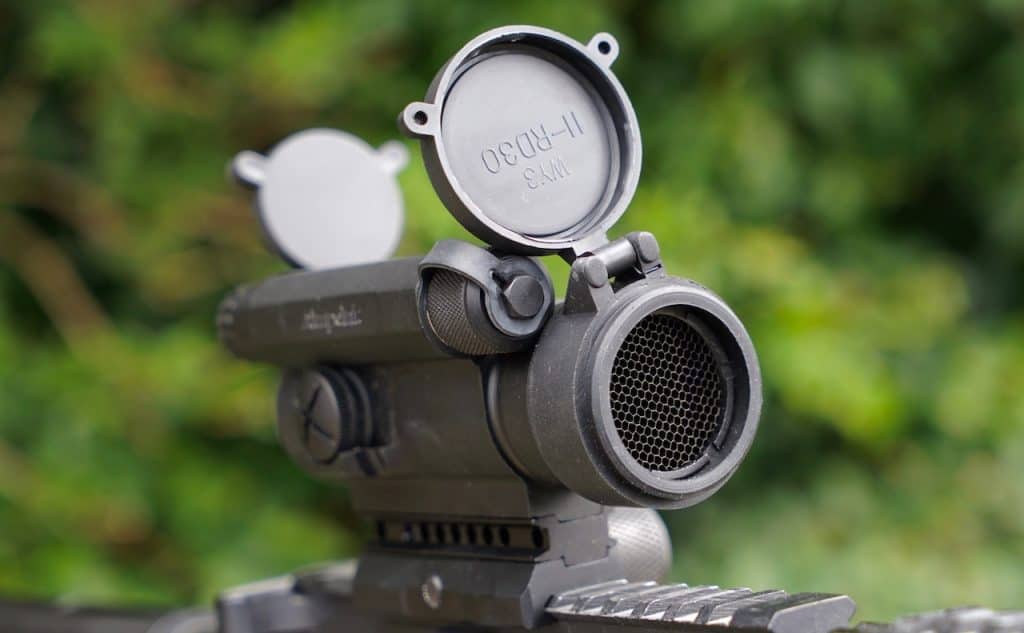Scopes, as with any other optics or high-tech gizmos, are accompanied by a barrage of foreign terminology that is not always obvious from the name as to what the heck the thing actually is
Appearance And Function
The killflash/ARD (anti-reflective device) or honeycomb filter is a darker colored honeycomb patterned filter that threads on over the objective lens of your scope.
This is meant to cut down on glare and obscure or camouflage the obvious flash or shininess of the lens when looking at it from the front. You can be perfectly concealed and on target, and if your quarry catches a glimpse of that lens flash, your cover’s blown!
Aside from the obvious purpose of this device, the
But, not unlike other things in front of your lens that obscures your image, that is the unfortunate drawback to having a

Are These Expensive?
The killflash, like any other accessory for your rifle or scope, is available at a wide variety of price points. Starting out at about $15, they can go all the way up to the $150 or $200 price range!
Aside from different fits and brands, they all have pretty much the same function and slight design differences, so I wouldn’t go off and pay for a really expensive one before using it to see if you are really going to like having one on your scope or not. You can even make one yourself very cheaply.
Durability
The killflash is a lightweight and surprisingly durable piece of equipment. It is usually made from lightweight steel or aluminum and screws into the front of the lens of optics that are threaded for these types of adaptations. Most of these weigh less than an ounce.
There are killflashes that are made in a square shape for use with reflex sights to conceal the glow of the red dot.
Difference Between The Killflash And Sunshade
There are many differences between the killflash and the sunshade. Both are meant to shade the lens to reduce glare, but that’s about the only similarity. The killflash is more for concealing the flash of the lens from the frontal view so as not to give away your position, while the sunshade is simply there to shade the glare from the sun for the shooter.
The most obvious difference to the physical appearance. The killflash has a very noticeable and distinct honeycomb pattern which is how it does its filtering and is much shorter, while the sunshade is just basically an overhang that shades the optic and adds much more to the overall size of the scope.
A killflash of the correct size will fit your scope as long as the scope has threads in front of the objective lens for these types of adaptations, while the sunshade is made very specifically for each individual scope. Even with this, the sunshade is usually the less expensive of the two options.
Pros
- Killflashes shield the glare or flash of the optic from the front, so as to not give away your position
- protects your objective lens from dirt and grime
- come in a variety of price points, but can start off very reasonably
- lightweight and durable
- available in different sizes and shapes to accommodate different types of optics
- very easy to just make your own
Cons
- patterning is noticeable and can affect your precision
- reduces images brightness and light intake
- can get “stuck” to your lens and be difficult to screw on or off
Make Your Own
There are many ways that you can make your own killflash cheaply and easily. You can basically use any material that that looks similar and produces the desired results. Any honeycomb or screen type material in flat black ought to work just fine as long as it doesn’t obscure your image too much.
One method is to take a flip-up cap that fits your scope and some charcoal window screen or bug screen from any hardware store. Cut the screen to the proper size to fit over the end of your scope on the objective lens side. Make sure you have a little bit of overlap. Then just secure the flip-up cap over top to hold it in place. This works just as well and costs only a few dollars!
Some people have used old filters or the honeycomb catalyst structures out of junk car parts and cut them down to size. You can get creative!
Another easy method is to use black coffee stirring straws. You use a sunshade and fill it tightly with the stirring straws. Then, secure the straws when they are snug with black electrical tape. Carefully cut the straw bundle to the correct length and make sure they are nice and smooth edged and even.
Wrap the bundle once more tightly with black tape and work it into the sunshade about halfway or three-quarters of the way in. You need some protrusion in order to remove the bundle if you want to.
Conclusion
Hopefully, you now have a pretty good grasp on what a killflash is and if it’s something you really want or need. Pretty much, for tactical or hunting applications it’s a great accessory to have.
If you’re a competition or range shooter, you might just want to stick with a sunshade. I would try making or borrowing one first and see if you like the results before purchasing an expensive killflash. Happy shooting!
If you enjoyed this article you’ll probably like these:


